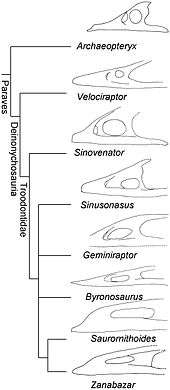Geminiraptor
| Geminiraptor | |
|---|---|
 | |
| The holotype maxilla in multiple views | |
| Scientific classification | |
| Kingdom: | Animalia |
| Phylum: | Chordata |
| Clade: | Dinosauria |
| Order: | Saurischia |
| Suborder: | Theropoda |
| Family: | †Troodontidae |
| Genus: | †Geminiraptor Senter et al., 2010 |
| Species: | †G. suarezarum |
| Binomial name | |
| Geminiraptor suarezarum Senter et al., 2010 | |

Geminiraptor is a genus of troodontid dinosaur. Geminiraptor lived during the early Cretaceous period (?lower Barremian age) in what is now Utah, United States. Geminiraptor was named by Phil Senter, James I. Kirkland, John Bird and Jeff A. Bartlett in 2010. The type species of Geminiraptor is G. suarezarum. The specific name refers to Drs. Celina and Marina Suarez, the twin geologists who discovered the Suarez site. The generic name is from the Latin geminae (“twins,” in honor of the Suarez sisters) and raptor ("seizer").[1]
Description
The holotype and only known specimen of Geminiraptor is CEUM 7319, a maxilla recovered from the lower Yellow Cat Member of the Cedar Mountain Formation, dating to at least the early Barremian stage (about 130 million years ago). The maxilla is long and low, with the process above the antorbital fenestra being horizontal, similar to other advanced troodontids. However, some features of the maxilla are more similar to the condition in basal troodontids such as Sinovenator. These include the presence of a promaxillary fenestra which is visible in lateral view, a narrow promaxillary strut (the bar of bone between the maxillary and promaxillary fenestrae), and a narrow interfenestral strut (the bar of bone between the maxillary and antorbital fenestrae).[1]
Geminiraptor is uniquely characterized by the presence of a large pneumatic chamber which expands the maxilla into a triangular shape in cross section, with the base formed by a bony shelf lingual to the teeth. Nine alveoli are preserved, although since both the anterior and caudal tips of the maxilla are missing, certainly more were present. By comparing Geminiraptor's maxilla to that of other troodontids, it was inferred that at least three more teeth were present in the missing anterior part of the maxilla and at least seven in the missing caudal area, for a total of at least nineteen teeth in the maxilla. The alveoli are characteristically square-shaped and separated by small walls of bone, a feature only known in Sinovenator among other troodontids.[1]
Although still a rather small dinosaur, Geminiraptor is larger than most other early Cretaceous troodontids, with its maxillary proportions more similar to those of late Cretaceous genera.[1]
Classification
Geminiraptor is considered a troodontid, a classification supported due to its large number of small teeth. A phylogenetic analysis created by its describers placed it in a clade with derived troodontids due to the olbong shape of its maxillary fenestra. With that being said, the large amount of missing data for the genus means that its position with the family is not completely certain, and Geminiraptor may instead be a close relative of Sinovenator due to each of them having interdental bone walls, unlike all other known troodontids.[1]
